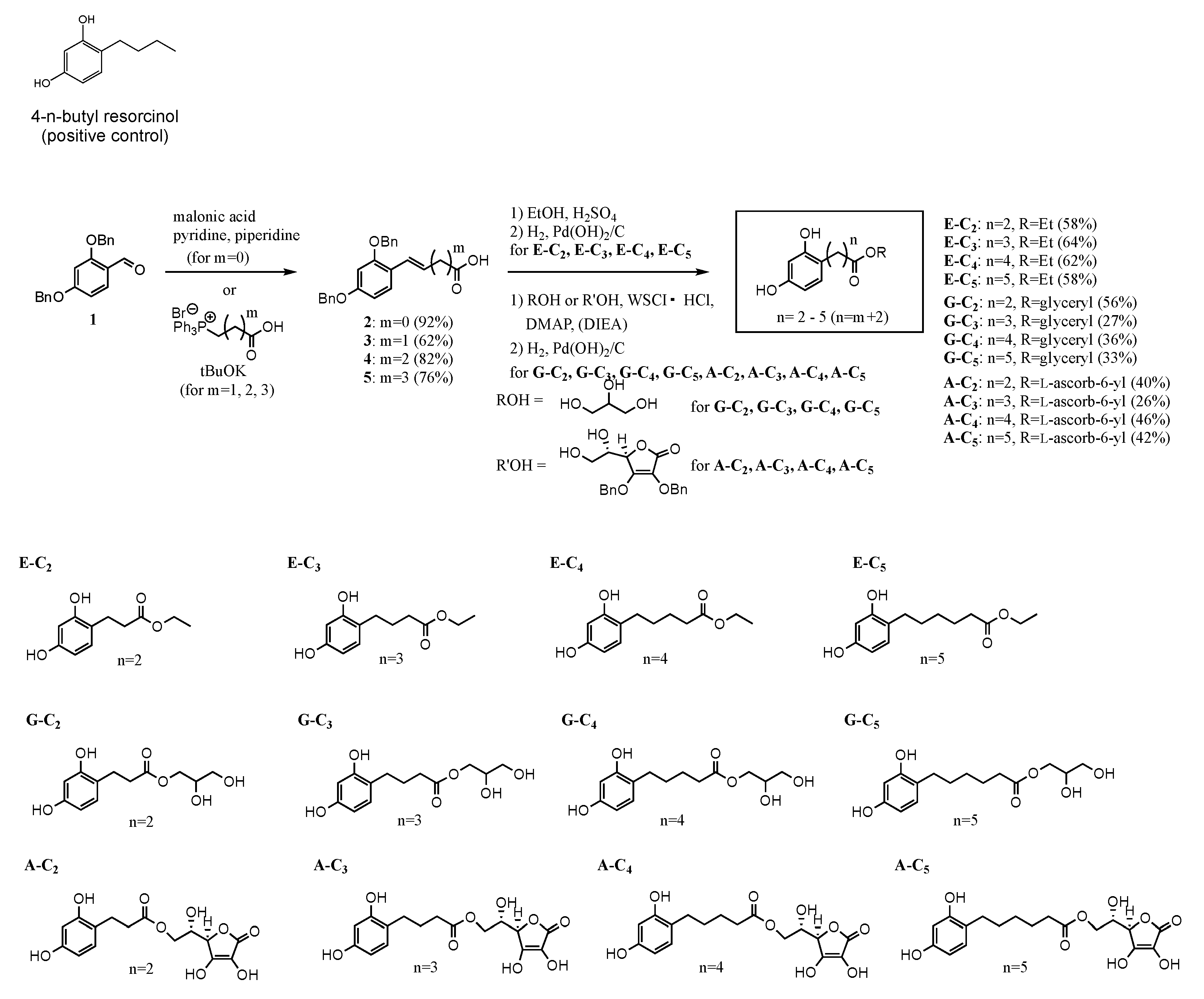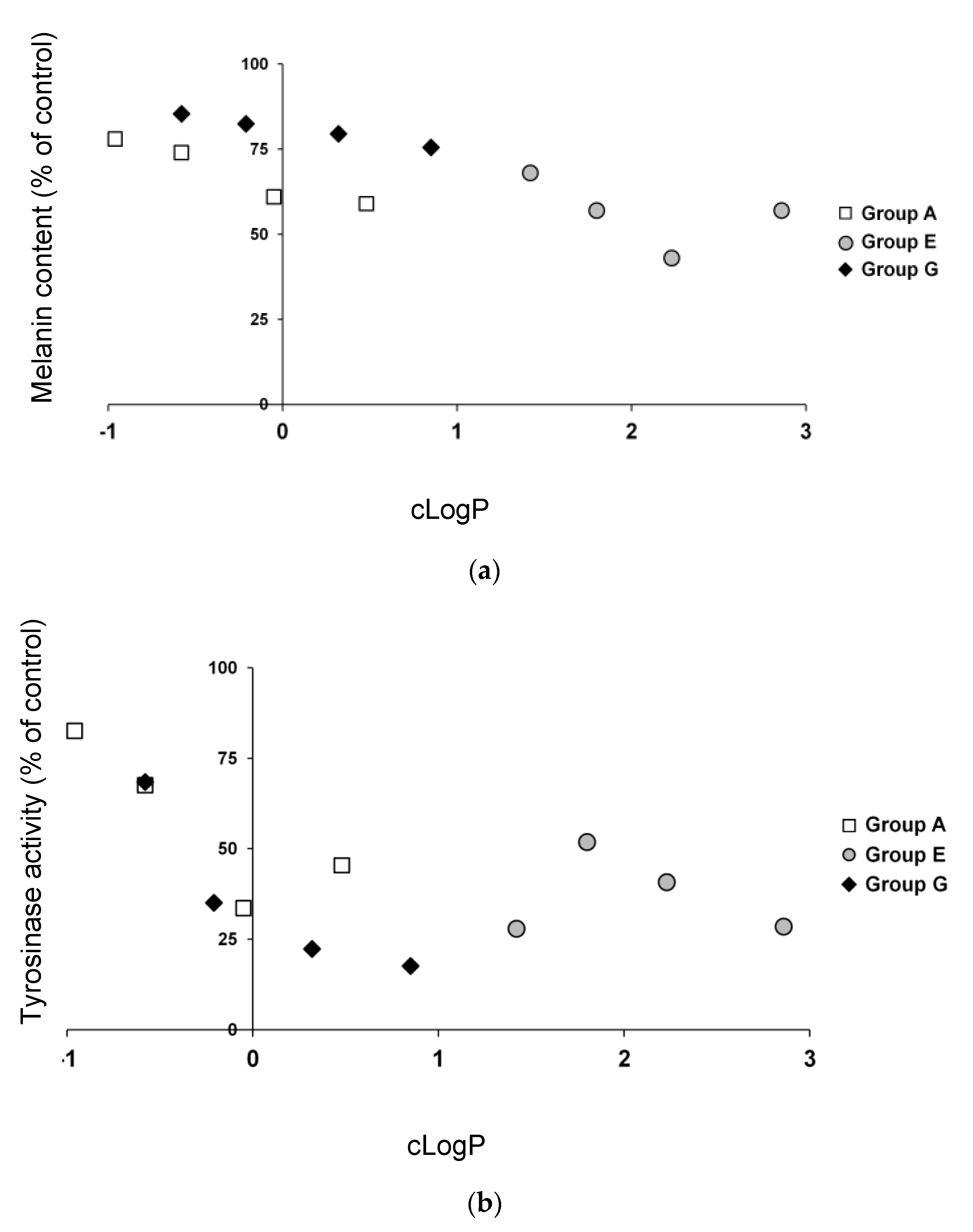Synthesis of Resorcinol Derivatives and their Effects on Melanin Production
Abstract
1. Introduction
2. Materials and Methods
2.1. Reagents
2.2. Chemicals
2.3. Synthesis of Compounds
2.4. Cell Culture
2.5. Measurement of Melanin Content
2.6. Measurement of Cell-Free Tyrosinase Activity
2.7. Statistical Analysis
3. Results
3.1. Effect of Resorcinol Derivatives on Cell Viability
3.2. Effect of Resorcinol Derivatives on Melanogenesis
3.3. Effect of Resorcinol Derivatives on Tyrosinase Activity
3.4. Structure—Activity Relationship of the Resorcinol Derivatives in Terms of their Tyrosinase Activity and Melanin Content
4. Discussion
5. Conclusions
Supplementary Materials
Author Contributions
Funding
Acknowledgments
Conflicts of Interest
References
- Ortonne, J.P. Normal and abnormal human skin color: From research to esthetics. Ann. Dermatol. Venereol. 2009, 136, S252–S256. [Google Scholar] [CrossRef]
- Ortonne, J.P. Normal and abnormal skin color. Ann. Dermatol. Venereol. 2012, 139, S73–S77. [Google Scholar] [CrossRef]
- Ortonne, J.P. La couleur de la peau normale ou anormaleNormal and abnormal skin color. Ann. Dermatol. Venereol. 2012, 139, S125–S129. [Google Scholar] [CrossRef]
- Maddodi, N.; Jayanthy, A.; Setaluri, V. Shining light on skin pigmentation: The darker and the brighter side of effects of UV radiation. Photochem. Photobiol. 2012, 88, 1075–1082. [Google Scholar] [CrossRef] [PubMed]
- Tsukamoto, K.; Jackson, I.J.; Urabe, K.; Montague, P.M.; Hearing, V.J. A second tyrosinase-related protein, TRP-2, is a melanogenic enzyme termed DOPAchrome tautomerase. The EMBO J. 1992, 11, 19–526. [Google Scholar] [CrossRef]
- Yokoyama, K.; Suzuki, H.; Yasumoto, K.; Tomita, Y.; Shibahara, S. Molecular cloning and functional analysis of a cDNA coding for human DOPAchrome tautomerase/tyrosinase-related protein-2. Biochim. Biophys. Acta. 1994, 1217, 317–321. [Google Scholar] [CrossRef]
- Kobayashi, T.; Urabe, K.; Winder, A.; Jiménez-Cervantes, C.; Imokawa, G.; Brewington, T.; Solano, F.; García-Borrón, J.C.; Hearing, V.J. Tyrosinase related protein 1 (TRP1) functions as a DHICA oxidase in melanin biosynthesis. The EMBO J. 1994, 13, 5818–5825. [Google Scholar] [CrossRef] [PubMed]
- Jiménez, M.; Tsukamoto, K.; Hearing, V.J. Tyrosinases from two different loci are expressed by normal and by transformed melanocytes. J. Biol. Chem. 1991, 266, 1147–1156. [Google Scholar]
- Tripathi, R.K.; Hearing, V.J.; Urabe, K.; Aroca, P.; Spritz, R.A. Mutational mapping of the catalytic activities of human tyrosinase. J. Biol. Chem. 1992, 267, 23707–23712. [Google Scholar] [PubMed]
- Prota, G. Progress in the chemistry of melanins and related metabolites. Med. Res. Rev. 1988, 8, 525–556. [Google Scholar] [CrossRef] [PubMed]
- Maeda, K.; Fukuda, M. Arbutin: Mechanism of its depigmenting action in human melanocyte culture. J. Pharmacol. Exp. Ther. 1996, 276, 765–769. [Google Scholar] [PubMed]
- Kahn, V. Effect of kojic acid on the oxidation of DL-DOPA, norepinephrine, and dopamine by mushroom tyrosinase. Pigment Cell Res. 1995, 8, 234–240. [Google Scholar] [CrossRef] [PubMed]
- Khatib, S.; Nerya, O.; Musa, R.; Tamir, S.; Peter, T.; Vaya, J. Enhanced substituted resorcinol hydrophobicity augments tyrosinase inhibition potency. J. Med. Chem. 2007, 50, 2676–2681. [Google Scholar] [CrossRef] [PubMed]
- Ando, H.; Ryu, A.; Hashimoto, A.; Oka, M.; Ichihashi, M. Linoleic acid and alpha-linolenic acid lightens ultraviolet-induced hyperpigmentation of the skin. Arch. Dermatol. Res. 1998, 290, 375–381. [Google Scholar] [CrossRef] [PubMed]
- Ando, H.; Funasaka, Y.; Oka, M.; Ohashi, A.; Furumura, M.; Matsunaga, J.; Matsunaga, M.; Hearing, V.J.; Ichihashi, M. Possible involvement of proteolytic degradation of tyrosinase in the regulatory effect of fatty acids on melanogenesis. J. Lipid. Res. 1999, 40, 1312–1316. [Google Scholar] [PubMed]
- Imokawa, G.; Kobayashi, T.; Miyagishi, M.; Higashi, K.; Yada, Y. The role of endothelin-1 in epidermal hyperpigmentation and signaling mechanisms of mitogenesis and melanogenesis. Pigment Cell Res. 1997, 10, 218–228. [Google Scholar] [CrossRef] [PubMed]
- Kolbe, L.; Mann, T.; Gerwat, W.; Batzer, J.; Ahlheit, S.; Scherner, C.; Wenck, H.; Stäb, F. 4-n-butylresorcinol, a highly effective tyrosinase inhibitor for the topical treatment of hyperpigmentation. J. Eur. Acad. Dermatol. Venereol. 2013, 1, 19–23. [Google Scholar] [CrossRef] [PubMed]
- Katagiri, T.; Okubo, T.; Oyobikawa, M.; Futaki, K.; Shaku, M.; Kawai, M. Novel melanogenic enzymes for controlling hyperpigmentation. In Proceedings of the 20th IFSCC International Congress, Cannes, France, 14–18 September 1998; Volume 39, pp. 1–11. [Google Scholar]
- Tasaka, K.; Kamei, C.; Nakano, S.; Takeuchi, Y.; Yamato, M. Effects of Certain Resorcinol Derivatives on the Tyrosinase Activity and the Growth of Melanoma Cells. Methods Find Exp. Clin. Pharmacol. 1998, 20, 99–109. [Google Scholar] [CrossRef] [PubMed]
- Shimizu, K.; Kondo, R.; Sakai, K.; Takeda, N.; Nagahata, T.; Oniki, T. Novel Vitamin E Derivative With 4-substituted Resorcinol Moiety Has Both Antioxidant and Tyrosinase Inhibitory Properties. Lipids 2001, 36, 1321–1326. [Google Scholar] [CrossRef] [PubMed]



| Derivative | R | N * | Molecular Weight | cLogP |
|---|---|---|---|---|
| A-C2 | L-Ascorb-6-yl (group A) | 2 | 340 | −0.96 |
| A-C3 | 3 | 354 | −0.58 | |
| A-C4 | 4 | 368 | −0.05 | |
| A-C5 | 5 | 382 | 0.48 | |
| E-C2 | Ethyl (group E) | 2 | 210 | 1.42 |
| E-C3 | 3 | 224 | 0 | |
| E-C4 | 4 | 238 | 2.33 | |
| E-C5 | 5 | 252 | 2.86 | |
| G-C2 | Glyceryl (group G) | 2 | 256 | −0.58 |
| G-C3 | 3 | 270 | −0.21 | |
| G-C4 | 4 | 284 | 0.32 | |
| G-C5 | 5 | 298 | 0.85 |
© 2020 by the authors. Licensee MDPI, Basel, Switzerland. This article is an open access article distributed under the terms and conditions of the Creative Commons Attribution (CC BY) license (http://creativecommons.org/licenses/by/4.0/).
Share and Cite
Tokudome, Y.; Hoshi, T.; Mori, S.; Hijikuro, I. Synthesis of Resorcinol Derivatives and their Effects on Melanin Production. Cosmetics 2020, 7, 55. https://doi.org/10.3390/cosmetics7030055
Tokudome Y, Hoshi T, Mori S, Hijikuro I. Synthesis of Resorcinol Derivatives and their Effects on Melanin Production. Cosmetics. 2020; 7(3):55. https://doi.org/10.3390/cosmetics7030055
Chicago/Turabian StyleTokudome, Yoshihiro, Tsuyoshi Hoshi, Sayaka Mori, and Ichiro Hijikuro. 2020. "Synthesis of Resorcinol Derivatives and their Effects on Melanin Production" Cosmetics 7, no. 3: 55. https://doi.org/10.3390/cosmetics7030055
APA StyleTokudome, Y., Hoshi, T., Mori, S., & Hijikuro, I. (2020). Synthesis of Resorcinol Derivatives and their Effects on Melanin Production. Cosmetics, 7(3), 55. https://doi.org/10.3390/cosmetics7030055






